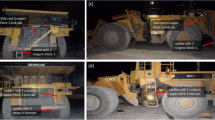Abstract
Researchers from the National Institute for Occupational Safety and Health (NIOSH) developed a light-emitting diode (LED) area luminaire called the Saturn and conducted a laboratory study using a Fletcher High Dual-boom Mast Feed (HDDR) roof bolting machine. The Saturn luminaire was designed to (1) enhance floor illumination to enable better detection of trip hazards in the interior spaces of a roof bolter and (2) reduce glare that has typically been an issue of concern on roof bolters. This paper reports on the results of achieving the second objective. The existing roof bolter lighting was the baseline and was compared with three versions of the Saturn luminaire relative to light intensity (100%, 75%, and 50%). Discomfort and disability glare data were obtained from 30 participants that comprised three age groups. Discomfort glare perceptions were obtained using the De Boer rating scale, and disability glare was quantified by using Mars Letter Contrast Sensitivity tests. Discomfort glare was reduced at least 3 levels with all Saturn versions. Also, a predictive model was used to estimate discomfort glare, and the results were similar. Disability glare was the least for the Saturn’s 50% intensity, and all Saturn versions had significantly less disability glare than with the baseline lighting. Veiling luminance was calculated and used as another indicator of disability glare. Veiling luminance was 28 to 42 times greater with the baseline lighting as compared with that of the Saturn lighting. Lastly, visibility levels were calculated. The Saturn versions were 4 to 6.5 times better in terms of visibility level.











Similar content being viewed by others
References
Groves WA, Kecojevic VJ, Komljenovic D (2007) Analysis of fatalities and injuries involving mining equipment. J Saf Res 38(4):461–470
MSHA. Accident, illness and injury and employment self-extracting files (part 50 data), 2004–2013. [cited 2019 ]; Available from: http://www.msha.gov/STATS/PART50/p50y2k/p50y2k.HTM. Accessed 20 May 2019
Center, L.R. Glossary. National Lighting Product Information Program 2018 10/24/18]; Available from: https://www.lrc.rpi.edu/programs/NLPIP/glossary.asp
Institute, A.G (2003) Dictionary of mining mineral, and related terms, 2nd edn. Springer Berlin Heidelberg
Van Derlofske J, et al (2004) Headlamp parameters and glare. In SAE 2004 World Congress & Exhibition. SAE
Bullough J, Van Derlofske J, and Fu Z (2002) Discomfort and disability glare from halogen and HID headlamp systems. in SAE 2002 World Congress & Exhibition
Bullough J, et al. 2003 An investigation of headlamp glare: intensity, spectrum and size
Schieber F (1994) Age and glare recovery time for low-contrast stimuli. in Proceedings of the Human Factors and Ergonomics Society Annual Meeting. SAGE Publications Sage CA, Los Angeles
Lulla AB, Bennett CA (1981) Discomfort glare: range effects. J Illum Eng Soc 10(2):74–80
Bullough JD, Hickcox KS, Narendran N (2011) A method for estimating discomfort glare from exterior lighting systems. Assist Recommends 9(1):1–7
Bullough JD et al (2008) Predicting discomfort glare from outdoor lighting installations. Light Res Technol 40(3):225–242
Gellatly AW and Weintraub DJ (1990) User reconfigurations of the de Boer rating scale for discomfort glare, U.o.M.T.R. Institute, Editor. Ann Arbor
Fotios S (2015) Research note: uncertainty in subjective evaluation of discomfort glare. Light Res Technol 47(3):379–383
Villa C, Bremond R, Saint-Jacques E (2017) Assessment of pedestrian discomfort glare from urban LED lighting. Light Res Technol 49(2):147–172
Lin Y et al (2014) Model predicting discomfort glare caused by LED road lights. Opt Express 22:18056–18071
Sammarco JJ et al (2009) Evaluation of glare for incandescent and LED miner cap lamps in mesopic conditions. Min Eng 61(6):99–106
Sammarco JJ et al (2011) Discomfort glare comparison for various LED Cap Lamps. IEEE Trans Ind Appl Soc 47(3):1168–1174
Reyes M, Gallagher S, Sammarco JJ (2013) Evaluation of visual performance when using incadescent, fluorescent, and LED machine lights in mesopic conditions. IEEE Trans Ind Appl 49(5):1992–1999
Sammarco JJ (2018) NIOSH Saturn area light. 10/24/2017 8/28/18]; Available from: https://www.cdc.gov/niosh/mining/content/saturnarealight.html
Sammarco J et al (2018) LED lighting for improving trip object detection for a walk-thru roof bolter. Light Res Technol 0(0):1–17
Blanco M, Hankey J, and Dingus T (2005) Vol. IV: Phase II-study 2: visual performance during nighttime driving in rain, in Enhanced Night Visibility Series, US Department of Transportation
Aslam TM, Haider D, Murray IJ (2007) Principles of disability glare measurement: an ophthalmological perspective. Acta Ophthalmol Scand 85:354–360
De Boer J (1967) Visual perception in road traffic and the field of vision of the motorist. Publ Light:11–96
Rea MS (1993) IES lighting handbook, 8th Edition, Reference and Application Volume: Illuminating Engineering Society of North America
Kaufman J (1981) IES lighting handbook, Application Volume. Illuminating Engineering Society of North America
Blackwell HR (1946) Contrast thresholds of the human eye. J Opt Soc Am 36(11):624–643
Schmidt-Clausen HJ, Bindels JTH (1974) Assessment of discomfort glare in motor vehicle lighting. Light Res Technol 6(2):79–88
Stiles W, Herbert P (1929) The effect of glare on the brightness difference threshold. Proc R Soc B:104(731)
Cornelius K, Steiner L, and Turin F (1998) Using coal miners’ experience to identify effective operating cues, in 42nd Annual Meeting of the Human Factors and Ergonomics Society
Acknowledgments
The authors acknowledge the contributions of NIOSH personnel Jason Navoyski, Max Martell, Brendan Demich, and J.T. Lippert in conducting this research and thank the J.H. Fletcher & Co™ for use of the mine roof bolting machine.
Author information
Authors and Affiliations
Corresponding author
Ethics declarations
Conflict of Interest
The authors state that there is no conflict of interest.
Disclaimer
The findings and conclusions in this paper are those of the authors and do not necessarily represent the official position of the National Institute for Occupational Safety and Health, Centers for Disease Control and Prevention. Mention of any company or product does not constitute endorsement by NIOSH.
Additional information
Publisher’s Note
Springer Nature remains neutral with regard to jurisdictional claims in published maps and institutional affiliations.
Rights and permissions
About this article
Cite this article
Sammarco, J.J., Mayton, A.G. & Rubinstein, E.N. LED Area Lighting to Reduce Glare for Roof Bolter Operators. Mining, Metallurgy & Exploration 37, 851–860 (2020). https://doi.org/10.1007/s42461-020-00193-x
Received:
Accepted:
Published:
Issue Date:
DOI: https://doi.org/10.1007/s42461-020-00193-x




